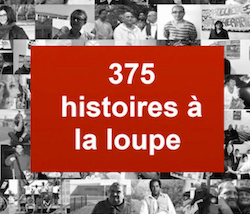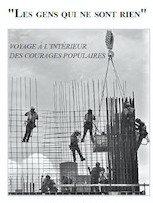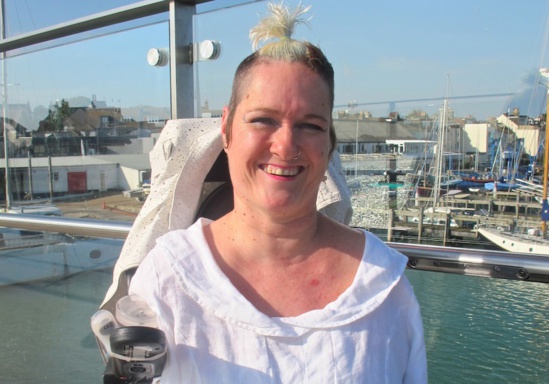
© Nicolas Rouger-Divet
Alison Lapper talks without taboo. She enjoys imagery that puts her conversant ill at ease. She’s always ready to give a hand. She would never kneel in front of anybody (but might play footsie, especially if the concerned party is tall and dark, “my kind of man”, she says).
Alison was born in 1965 with phocomelia. Hidden from her mother, and taken in care by the state since birth, she grows up in an institution in the British countryside. The system teaches her to be independent while expecting her to fail. But today, she walks, runs, swims; she drives, she flirts, sometimes scandalously.
After showing particular sensitivity for the arts as early as 3 years old, she becomes a member of the Association of Mouth and Foot Painting Artists (AMFPA) at 16. The international organization, which is not a charity, represents artists, who, like Alison, paint with their mouth and feet, and organises the sale of cards based on their illustrations to provide them with an income.
Alison was born in 1965 with phocomelia. Hidden from her mother, and taken in care by the state since birth, she grows up in an institution in the British countryside. The system teaches her to be independent while expecting her to fail. But today, she walks, runs, swims; she drives, she flirts, sometimes scandalously.
After showing particular sensitivity for the arts as early as 3 years old, she becomes a member of the Association of Mouth and Foot Painting Artists (AMFPA) at 16. The international organization, which is not a charity, represents artists, who, like Alison, paint with their mouth and feet, and organises the sale of cards based on their illustrations to provide them with an income.
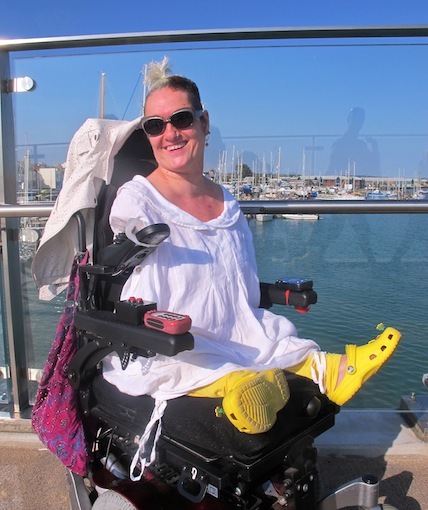
© Nicolas Rouger-Divet
“I was the only one not to be chatted up to, it does something to you.”
At 18, as she moves to London, she discovers a new world of possibilities. Finally out of the ‘system’, she is free to make her own experiences. She confronts the reality of life outside the closed off world she knew during her childhood. “Now, I don’t care, but obviously, when we would go out dancing and I was the only one not to be chatted up to, it does something to you.”
She becomes the first disabled person to study fine arts at Sussex University, in Brighton (which awarded her a honorary doctorate in 2014 for her contribution to the arts). This is where she fashions her path as an artist, the one that will define her personality. Instead of sticking to painting, she exhibits mouldings of her naked body. The reactions are positive or negative, but never neutral. Today, her body of work still focuses on the body and the perceptions of the body.
“The public likes to draw a parallel between my statues and the Venus de Milo. This comparison is representative of the aesthetic system in which we live. The beauty of the Venus resides in the extension of the statue, in what it was before she lost her arms, and not in its beauty as is. For people who are born disabled, the perspective is completely different.”
She becomes the first disabled person to study fine arts at Sussex University, in Brighton (which awarded her a honorary doctorate in 2014 for her contribution to the arts). This is where she fashions her path as an artist, the one that will define her personality. Instead of sticking to painting, she exhibits mouldings of her naked body. The reactions are positive or negative, but never neutral. Today, her body of work still focuses on the body and the perceptions of the body.
“The public likes to draw a parallel between my statues and the Venus de Milo. This comparison is representative of the aesthetic system in which we live. The beauty of the Venus resides in the extension of the statue, in what it was before she lost her arms, and not in its beauty as is. For people who are born disabled, the perspective is completely different.”
“I spent my life destroying barriers”
Despite this position, Alison does not meddle in politics, and especially not through her art. “I hate political correctness, I say what I think. I spent my life destroying barriers, often directly and violently. But for me, my nudity, my sexuality, themes that come back repeatedly in my work, are topics that are personal, a way of discovering myself. It is others make it a controversy. I am Alison Lapper, and I am unique, not because of my disability (a term I challenge anyways), but thanks to my personality. Everybody’s identity is formed through the difficulties that society imposes on us. It could have been my sexual orientation, or my skin colour.”
At 34, Alison gives birth to Parys, after suffering several miscarriages in her twenties. Parys’s father leaves before the birth, but Alison is convinced of her choice to keep the child. “Obviously, I knew already that it would be a sacrifice, chiefly on the physical level: I have arthritis all along my spine, and I am in a wheelchair half the time now - something I would have never accepted at 20.” People tried to discourage her, as phocomelia can be transmitted genetically. But she’s very clear with herself: “I told myself: if he’s born like me, who could take care of him and educate him better than me?”
At 34, Alison gives birth to Parys, after suffering several miscarriages in her twenties. Parys’s father leaves before the birth, but Alison is convinced of her choice to keep the child. “Obviously, I knew already that it would be a sacrifice, chiefly on the physical level: I have arthritis all along my spine, and I am in a wheelchair half the time now - something I would have never accepted at 20.” People tried to discourage her, as phocomelia can be transmitted genetically. But she’s very clear with herself: “I told myself: if he’s born like me, who could take care of him and educate him better than me?”
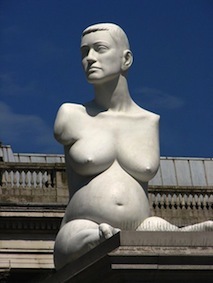
The disturbing statue of Trafalgar Square
This change of life does not go unnoticed. During her pregnancy, she accepts to pose for the artist Marc Quinn. The statue, simply named Alison Lapper Pregnant, becomes emblematic.
More than 3 meters 50 high, the sculpture makes the headlines when, in 2005, it is installed on the fourth plinth in Trafalgar Square, right in the centre of the English capital. It stays there for more than two years. Some call it an act of courage, like the Mayor of London of the time, Ken Livingstone, but it also inspires disgust in many, including the Sun, the most read tabloid in the country.
“They had to publicly apologise eventually, otherwise I wouldn’t have given them the interview they asked for.” She also accepts to take part in the BBC series Child of our Time, which follows around twenty adolescents born around the year 2000, during their childhood and adolescence.
More than 3 meters 50 high, the sculpture makes the headlines when, in 2005, it is installed on the fourth plinth in Trafalgar Square, right in the centre of the English capital. It stays there for more than two years. Some call it an act of courage, like the Mayor of London of the time, Ken Livingstone, but it also inspires disgust in many, including the Sun, the most read tabloid in the country.
“They had to publicly apologise eventually, otherwise I wouldn’t have given them the interview they asked for.” She also accepts to take part in the BBC series Child of our Time, which follows around twenty adolescents born around the year 2000, during their childhood and adolescence.
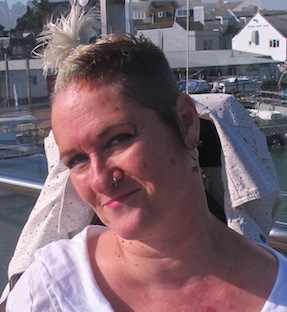
© Nicolas Rouger-Divet
Doing it by herself, for herself
Her choice to show the world the life that she lives with Parys is pragmatic, and sometimes financial. She also gets to prove to herself she had the ability to be a mum. “I didn’t know if I would manage. I had no maternal points of reference, no relation with my mother, or my grandmother, and very few examples of ‘normal’ families around me.”
“Parys and I never really benefited from any personal space. I lived by myself for more than twenty years, but since he’s been with me, I’ve needed somebody’s support at home. When he was very small, I could lift him up by my teeth. After he started to walk, at around 13 months, it became more difficult”
The public eye, its cameras that come through again and again (the Lapper family is getting ready to welcome a Korean documentary crew), are just a part of the attention that society lends to this atypical family. Since well before Parys’s birth, social services have not trusted Alison’s abilities to take care of her child. She must confront hostile attitudes that force her “not only to prove I am an adequate mother, but also that my child is perfect.”
She regrets this lack of support, which remains true until today, despite sustained positive recommendations by social workers. “I was told this year that a procedure had started to determine whether Parys should become my carer. He is going to be 15, so they think he is old enough: I will lose the benefits I received until now and that contribute to the salary of my personal assistant.”
“Parys and I never really benefited from any personal space. I lived by myself for more than twenty years, but since he’s been with me, I’ve needed somebody’s support at home. When he was very small, I could lift him up by my teeth. After he started to walk, at around 13 months, it became more difficult”
The public eye, its cameras that come through again and again (the Lapper family is getting ready to welcome a Korean documentary crew), are just a part of the attention that society lends to this atypical family. Since well before Parys’s birth, social services have not trusted Alison’s abilities to take care of her child. She must confront hostile attitudes that force her “not only to prove I am an adequate mother, but also that my child is perfect.”
She regrets this lack of support, which remains true until today, despite sustained positive recommendations by social workers. “I was told this year that a procedure had started to determine whether Parys should become my carer. He is going to be 15, so they think he is old enough: I will lose the benefits I received until now and that contribute to the salary of my personal assistant.”
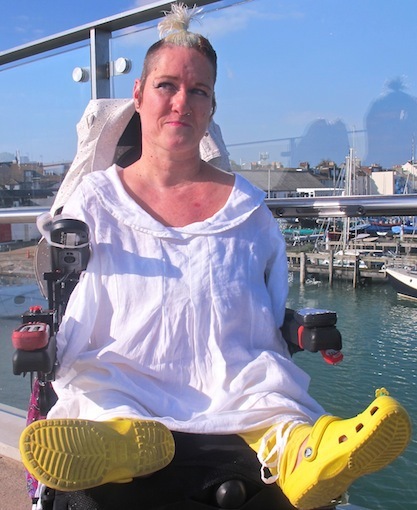
© Nicolas Rouger-Divet
“My son is a Nazi’s nightmare”
When Parys passes unexpectedly in front of the café, his body language is unique for a 14-year old. The moody adolescent pout, the addiction to video games are to be expected, but not the fact that he comes to embrace his mum, voluntarily but grudgingly. It’s a strange paradox.
“Parys is very conscious of his power over me: he’s 14, and already 5’7”. Since he’s very young, he had to adapt to this physical difference, instinctively. I never really had to touch him to make him understand some things, like looking on both sides of the road before crossing. “ There are universal lessons in this different education.
Isn’t this child that always surprises her, and that is so different from her, also the ultimate artistic expression?
“In a sense, yes. He is perfect. My son is a Nazi’s nightmare, a tall, blue-eyed, blond boy, born of the worst of cripples. It is quite in line with who I am, the jester: showing life the finger. At the same time, Parys was firstly the result of chance, and his education is the result of new discoveries, at every corner. That is completely opposite to my character as an artist. I tend to create in a reasoned, planned way.”
“Parys is very conscious of his power over me: he’s 14, and already 5’7”. Since he’s very young, he had to adapt to this physical difference, instinctively. I never really had to touch him to make him understand some things, like looking on both sides of the road before crossing. “ There are universal lessons in this different education.
Isn’t this child that always surprises her, and that is so different from her, also the ultimate artistic expression?
“In a sense, yes. He is perfect. My son is a Nazi’s nightmare, a tall, blue-eyed, blond boy, born of the worst of cripples. It is quite in line with who I am, the jester: showing life the finger. At the same time, Parys was firstly the result of chance, and his education is the result of new discoveries, at every corner. That is completely opposite to my character as an artist. I tend to create in a reasoned, planned way.”
“Art allows people to get out of their comfort zone”
“Life poses a lot of questions, especially regarding our identity, our roots, our futures, to which there are no straight answers. Art allows people to think, to get out of their comfort zone, and so to find their own answers. Educating a child, in a sense, is the same thing: it poses a lot of questions, but life will never give answers. It is a mirror to the creative process of every artist.”
Parys is not always impressed by his mum, the big mouth. Will he manage to escape the media life, the image of the son of a disabled mother? “I trust him. Obviously, I am always scared of having made mistakes, but we will just have to live and see. When he will be 25, it will be interesting to see what he thinks of me, of his childhood.”
Alison’s oeuvre is always in movement. She is currently working on a new photographic project around the adolescent body. But Alison will always escape Alison: an inflatable reproduction of Marc Quinn’s statue became one of the symbols of the United Kingdom at the 2012 Olympic Games opening ceremony in London, before being exhibited at the Venice biennal in 2013. It remains just as controversial.
Parys is not always impressed by his mum, the big mouth. Will he manage to escape the media life, the image of the son of a disabled mother? “I trust him. Obviously, I am always scared of having made mistakes, but we will just have to live and see. When he will be 25, it will be interesting to see what he thinks of me, of his childhood.”
Alison’s oeuvre is always in movement. She is currently working on a new photographic project around the adolescent body. But Alison will always escape Alison: an inflatable reproduction of Marc Quinn’s statue became one of the symbols of the United Kingdom at the 2012 Olympic Games opening ceremony in London, before being exhibited at the Venice biennal in 2013. It remains just as controversial.
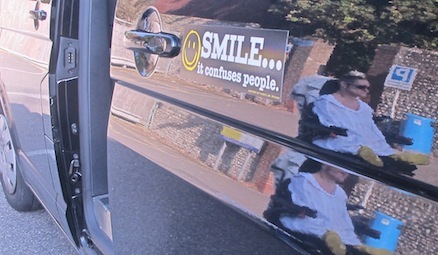
© Nicolas Rouger-Divet
Smile - it confuses people
“Obviously, many people tell me that I’m hurting the cause of disabled people: the statue in the Olympic Games can make it seem like there are no problems for disabled people in the UK. I am not a heroine of political combat. I am me, Alison Lapper. I have lots of questions, and I think all the answers must be individual and personal.”
Alison does painting workshops for children in local primary schools, “I make them paint with their mouth, with their feet. I did that with Parys too. It allows them to think about disability without having to give them lessons.” Children ask her without prejudice how she washes her bottom; she laughs: “children are extraordinary. They ask lots of questions. The problem is with the adults.”
We come out and follow one of the main roads of Alison’s sunny village of Shoreham-on-Sea, next to Brighton. The stares can be cumbersome, but Alison only thinks to describe the love she has for this region of the world, full of the eccentric artists that England does so well. She drops me off at the station, and we hug warmly. I have the feeling of having entered a different world, for a few hours. I smile, full of fighting optimism, while I watch her van disappear. On the rear window, a motto: ‘Smile - it confuses people’
Nicolas Rouger-Divet
TWO VIDEOS ABOUT ALISON LAPPER
Alison does painting workshops for children in local primary schools, “I make them paint with their mouth, with their feet. I did that with Parys too. It allows them to think about disability without having to give them lessons.” Children ask her without prejudice how she washes her bottom; she laughs: “children are extraordinary. They ask lots of questions. The problem is with the adults.”
We come out and follow one of the main roads of Alison’s sunny village of Shoreham-on-Sea, next to Brighton. The stares can be cumbersome, but Alison only thinks to describe the love she has for this region of the world, full of the eccentric artists that England does so well. She drops me off at the station, and we hug warmly. I have the feeling of having entered a different world, for a few hours. I smile, full of fighting optimism, while I watch her van disappear. On the rear window, a motto: ‘Smile - it confuses people’
Nicolas Rouger-Divet
TWO VIDEOS ABOUT ALISON LAPPER




 Engagés
Engagés